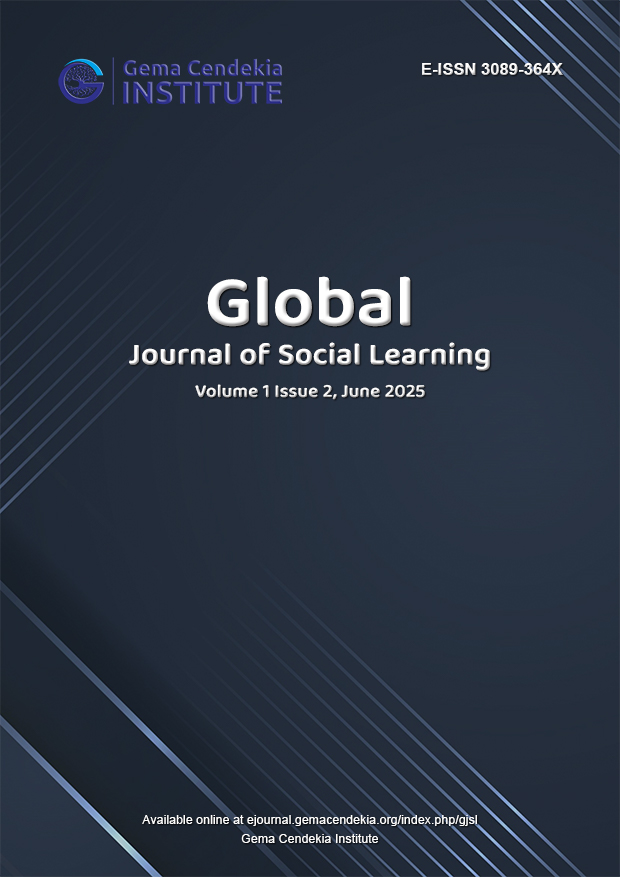Teater Koma's Dramaturgical Strategy in Delivering Social Criticism of the New Order Era
DOI:
https://doi.org/10.71094/gjsl.v1i2.102Keywords:
Dramaturgi, Teater Koma, Kritik Sosial, Orde Baru, Opera KecoaAbstract
This study examines the dramaturgical strategies employed by Teater Koma to convey social criticism during the New Order era, a period marked by stringent political censorship that constrained artistic expression. Focusing on a case study of the 1985 performance of Opera Kecoa, this research analyzes how dramaturgical components such as the script, characterization, symbolism, and satirical humor are strategically utilized to articulate social and political injustices. Employing a qualitative methodology, the study draws upon text analysis and performance documentation to explore these elements in depth. The findings reveal that Teater Koma creatively circumvented censorship through the use of symbolic language, allegorical storytelling, and nuanced narrative structures, enabling the theater to raise public awareness without directly contravening the political restrictions of the time. This dramaturgical approach functioned not only as an artistic expression but also as a subtle form of resistance against authoritarian suppression. The study underscores the critical role of theater as a medium for socially engaged discourse and political critique within repressive regimes.
References
Brecht, B. (1964). Brecht on theatre: The development of an aesthetic. Hill and Wang.
Carlson, M. (1993). Theories of the theatre: A historical and critical survey. Cornell University Press.
Foulcher, K. (1997). Writers as intellectuals: Indonesian literature and cultural politics of the New Order. Jurnal Kalam, 8, 45–66.
Harahap, I. (2007). Dramaturgy: Theory and its application in performing arts. Komunitas Bambu.
Heryanto, A. (2006). State terrorism and political identity in Indonesia. Routledge.
Hutcheon, L. (1985). A theory of parody: The teachings of twentieth century art forms. University of Illinois Press.
Mack, N., Woodsong, C., Macqueen, K. M., Guest, G., & Namey, E. (2005). Qualitative research methods: A data collector’s field guide (Vol. 13).
Masunah, J., Nugraheni, T., & Sunaryo, A. (2021). Pemberdayaan komunitas seni melalui produksi pertunjukan berbasis kearifan lokal untuk penguatan desa wisata. Jurnal Abmas, 21(1), 1–10. https://doi.org/10.17509/abmas.v21i1.35470
Mohajan, H. (2018). Qualitative research methodology in social sciences and related subjects. Journal of Economic Development, Environment and People, 7(1), 1–29.
Mulder, N. (1998). Mysticism in Java: Ideology in Indonesia. The Pepin Press.
N, Sahrul (2015). Estetika struktur dan estetika tekstur pertunjukan teater Wayang Padang karya Wisran Hadi [Tesis, Institut Seni Indonesia Surakarta].
Pavis, P. (1998). Dictionary of the theatre: Terms, concepts, and analysis. University of Toronto Press.
Riantiarno, N. (1995). Opera kecoa. Teater Koma.
Santosa. (2008). Menggagas komunikasi musikal dalam pertunjukan gamelan. Jurnal Ilmu Komunikasi, 5(1), 65–80.
Schechner, R. (2003). Performance theory. Routledge.
Sen, K., & Hill, D. (2000). Media, culture and politics in Indonesia. Oxford University Press.
Suryadmaja, G. (2025a). Potensi seni Gendang Beleq dalam penguatan pariwisata. Kolektif: Jurnal Riset Ilmiah, 1(1), 13–23. Retrieved from https://ejournal.gemacendekia.org/index.php/jrim/article/view/42
Suryadmaja, G. (2025b). Sosiologi seni: Memahami interaksi antara seni dan masyarakat. In D. P. Ningsih (Ed.), PT Rajawali Media Utama.
Suryadmaja, G., Ardiyansyah, L. D. S., & Purwati, D. (2015). Mengoptimalkan hasil belajar mahasiswa melalui pengembangan media Rumah Cerita pada mata kuliah Tata Teknik Pentas Prodi Pendidikan Sendratasik UNU NTB. Jurnal Ilmiah Mandala Education, 1(2), 290–301
Suryadmaja, G., & Saearani, M. F. T. (2025). Cantata Deo: Jurnal Musik dan Seni Studi Estetika Seni Pertunjukan di Era Global, 3(1), 71–86.
Zuhri, M. I., Markarma, M. R., & Yuliatin, R. R. (2018). Bentuk dan fungsi pertunjukan teater Amaq Abir di Sanggar Pustaka Budaya Desa Marong Kecamatan Praya Timur Lombok Tengah. TAMUMATRA: Jurnal Seni Pertunjukan, 1(1), 51–62. https://doi.org/10.29408/tmmt.v1i1.1128
Downloads
Published
Issue
Section
License
Copyright (c) 2025 Taufik Mawardi, Fara Dayana Mohd Jufry (Author)

This work is licensed under a Creative Commons Attribution-ShareAlike 4.0 International License.










